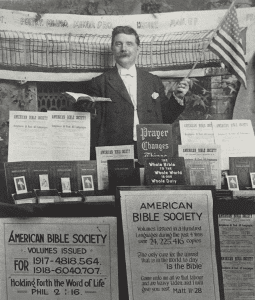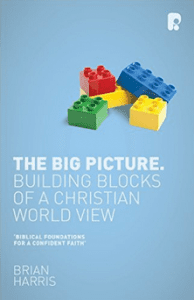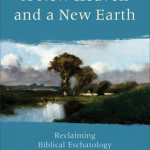 One of the more common arguments against evolution is the requirement of death before the fall. Not just death as a fact, but death as a mechanism of creation. It is often suggested that evolution is inconsistent with the notion of God as creator and creation as good. After all evolution relies on death and destruction, competition and conquest for life to develop and to progress … doesn’t it? The picture to the right, from Wikipedia, shows a hawk enjoying its natural meal, although the vole likely did not enjoy it much.
One of the more common arguments against evolution is the requirement of death before the fall. Not just death as a fact, but death as a mechanism of creation. It is often suggested that evolution is inconsistent with the notion of God as creator and creation as good. After all evolution relies on death and destruction, competition and conquest for life to develop and to progress … doesn’t it? The picture to the right, from Wikipedia, shows a hawk enjoying its natural meal, although the vole likely did not enjoy it much.
Alfred Lord Tennyson famously addressed the conflict between the love of God central in the Christian faith and the apparent bloody callousness of nature with an image that sticks in the imagination:
In Memoriam A. H. H., 1850
Are God and Nature then at strife,
That Nature lends such evil dreams?
So careful of the type she seems,
So careless of the single life;That I, considering everywhere
Her secret meaning in her deeds,
And finding that of fifty seeds
She often brings but one to bear,…
‘So careful of the type?’ but no.
From scarped cliff and quarried stone
She cries, ‘A thousand types are gone:
I care for nothing, all shall go.…
Man, her last work, who seem’d so fair,
Such splendid purpose in his eyes,
Who roll’d the psalm to wintry skies,
Who built him fanes of fruitless prayer,Who trusted God was love indeed
And love Creation’s final law-
Tho’ Nature, red in tooth and claw
With ravine, shriek’d against his creed-(excerpts from canto 55 and 56)
Nature red in tooth and claw, of fifty seeds but one brought to bear, a thousand types are gone. Tennyson wrote before Darwin’s The Origin of Species (1859), but after the influential book by Robert Chambers Vestiges of the Natural History of Creation published in 1844. (Darwin did not, we must remember, drop a new idea in the lap of an innocent and unsuspecting age, he was part of a swirling mass of ideas. He rushed publication of his ideas to avoid being scooped. Darwin had an important new insights, but if he had not published, some one else would have – and soon. )
It appears difficult to reconcile evolution with a God of love. For Tennyson the observation of the predators and prey along with the apparent wastefulness of the natural world was sufficient to raise questions. Darwin’s ideas of gradual change by natural selection takes it one step further. Predation, waste, extinction, and death are part of the creative process. A commenter on one of my posts several years ago out it quite bluntly: “Theistic evolution gives a false representation of the nature of God because death and ghastliness are ascribed to the Creator as principles of creation.“
But is this really true? When we consider evolution and natural selection we often think of it in terms of survival of the fittest. The vision is of competition and bloody fight, of victors and vanquished. But this is not the point. Fitness in biology has little to do with competition and victory in the local specific situation. Rather the fittest are those who raise most offspring, nothing more, nothing less. In the long run a variant with greater fitness will survive, but in the short term many will coexist. Evolution does require a natural cycle and process of life and death with successive generations. But this need be no more violent or wasteful than the world we see around us today. Each succeeding generation fulfills a role in the process of the unfolding of creation.
Yet the problem of death before the fall remains. Predators and prey, parasites and hosts. Part two of Ronald Osborn’s new book Death Before the Fall: Biblical Literalism and the Problem of Animal Suffering digs into this problem. Osborn views death as a theological puzzle, and one we must wrestle with. He starts the discussion, however, by pointing out that the problem is neither limited to nor especially acute for those of us who hold to an evolutionary creation. Animal suffering is at least as serious problem for a strictly literal young earth interpretation of Genesis as it is for an old earth progressive creation or an evolutionary creation.
The longer I have pondered these challenges [of evolutionary creation] , the more convinced I have become that they are far less severe than the theodicy dilemma posed by strict literalism or “scientific” creationism. (p. 127)
…
[I]t is left to creationists who attribute all of the dysteleological and troubling realities of of animal existence to God’s “curse” upon the animal kingdom to explain why a fully just, fully loving and omnipotent creator would not simply permit but positively demand such suffering among uncomprehending and morally innocent creatures who were previously unexposed to pain or death of any kind. (p. 128)
When the biblical tale is read as perfection -> Adam’s sin -> curse -> redemption ->new creation we still have a problem. The animals originally placed in a deathless world became subject to mortality and suffering as a result of Adam’s sin. Christ’s life, death, and resurrection provides an escape clause for humans, but the animals remain doomed to destruction in a consuming or cleansing fire.
Osborn sees three dilemmas attached to the traditional young earth reading of a perfect, originally deathless creation.
The stasis dilemma. A deathless creation will ultimately become as well a birthless creation. Unless, that is, we also imagine a creation with a constantly expanding earth. Given a finite earth, once the land is filled procreation must come to a halt.
A “perfect” world in the sense some believers demand would, it seems, be a world without any young or old … It would be a world without nurturing, nesting, or protecting of eggs, without rituals of courtship and mating, and without any new kinds of creatures ever emerging. It would be a creation without new creation. But would such a world really be “very good?” … A flawlessly engineered world without growth, without new birth, without change and without death might be “perfect” – like a finely calibrated watch. But “perfect” in this sense might not be good at all for God’s creative purposes. (p. 129)
It should be noted that a complete absence of death for all creation is not a uniform traditional reading. Osborn goes on to make a point that I’ve made in a number of posts over the years, most recently in Once Again: Immortality is a Divine Gift. Immortality for Adam and Eve was not a consequence of their created nature, but of their access to the tree of life in the center of the Garden (next to the troublesome tree of the knowledge of good and evil). Osborn concludes the section:
Humanity alone, a plain reading of the text strongly suggests, was granted special access to a provisional and renewable source of life. They alone forfeited this access through the exercise of their free wills, falling downward (if not backward) into the realm of mortal animal existence. (p. 131)
The Deceiver God Dilemma. Here Osborn describes the problems he sees with a mature creation. The appearance of age leads to God as the deceiver. The universe and the earth look old to all observation, we only know that they are actually young because the Bible tells us so. This isn’t simply Adam with a belly button and trees with rings. It is creation with the scars of calamities that never really happened. It is similar to proposing that Adam was created with a limp from a broken leg suffered when he was two and a jagged scar from from a fall when he was ten even although they never happened. Creation with a detailed history that never happened.
The Divine Curse Dilemma. Unlike the previous two dilemmas, here Osborn brings up a thought that hadn’t occurred to me before. Osborn finds this to be the most severe of the three dilemmas.
The natural world is filled with creatures that are anatomically “designed” – in their internal organs, their instincts, and practically every fiber of their physical structures – to exist by consuming other creatures. … How, then, did these predatory creatures – and indeed, the entire natural world as we know it right down to the cellular level and basic metabolism – arise? (p. 134)
Is this all a result of a divine curse that followed Adam’s sin?
 Osborn sees three possible answers to the divine curse dilemma, no satisfactory in his view.
Osborn sees three possible answers to the divine curse dilemma, no satisfactory in his view.
Possibility One. After the sin of Adam and Eve God gave the animal kingdom over to natural laws and over time the tools of predation evolved. This was a superspeed evolution we will note, far faster than any evolution proposed by modern scientists. The evolution from placid plant-eating sea creatures to great white sharks and killer whales occurred so rapidly in this scenario that we must conclude that God not only allowed it to happen but positively required it to happen. (The image of the Great White to the right, and the Leopard below are from Wikipedia.)
Possibility Two. After the sin of Adam and Eve God supernaturally modified or cursed the animal kingdom. This could have been immediate in a young earth view, or retroactive in a old earth progressive creation view. Osborn points to William Dembski’s book The End of Christianity: Finding a Good God in an Evil World where it is proposed that God in his foreknowledge of the sin of Adam and Eve created animal predation. This occurred to contain as well as to punish human sin.
But what kind of Creator would punish Adam and Eve’s rebellion – whether retroactively or proximately – by bending the rest of creation from a state of perfect peace into so many malign forms, supernaturally summoning into existence the snake’s venom and the jaguar’s teeth and commanding innocent creatures to begin devouring one another for the moral instruction or chastisement of humans? (p. 138)
Osborn also notes that the only creature cursed in Genesis 3 is the snake. There are consequences for Adam and Eve, but not a curse. The ground is cursed to produce thorns and thistles when Adam turns to farming – but the ground is not an animal. But for the snake there is a curse.
So the Lord God said to the serpent, “Because you have done this, cursed are you above all livestock and all wild animals!” (Gen 3:14)
A concept of a curse for all creatures is theological reading imposed on the situation, not a simple interpretation of the text we have.
 Possibility Three. The appearance of predatory animals may be the result of demonic forces at work in the world. The problem with such speculations is that they “give far greater creative powers to forces of satanic agency than Scripture ever does.” This seems to be a real theological problem although it may give some creationists comfort. Satan is responsible for the Hawk’s meal. Osborn suggests that this is a rather gnostic speculation. We have the forces of good and evil at war in all of creation.
Possibility Three. The appearance of predatory animals may be the result of demonic forces at work in the world. The problem with such speculations is that they “give far greater creative powers to forces of satanic agency than Scripture ever does.” This seems to be a real theological problem although it may give some creationists comfort. Satan is responsible for the Hawk’s meal. Osborn suggests that this is a rather gnostic speculation. We have the forces of good and evil at war in all of creation.
The point of this discussion is not to dismiss the problem of death and animal suffering as it applies to the perspective of evolutionary creation. Rather the point is that the problem of animal death, predation, and suffering is not limited to the Christian evolutionist. It is a problem for all Christians what ever their view of creation. Perhaps, however, it is less of a problem for old earth evolutionary creation than for old earth progressive creation or for young earth creation.
Is animal death, suffering, and predation a theological problem?
Why or why not?
If you wish to contact me directly you may do so at rjs4mail[at]att.net
If interested you can subscribe to a full text feed of my posts at Musings on Science and Theology.











